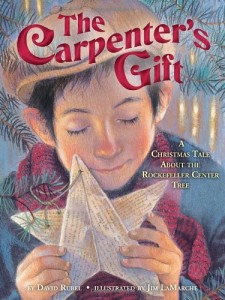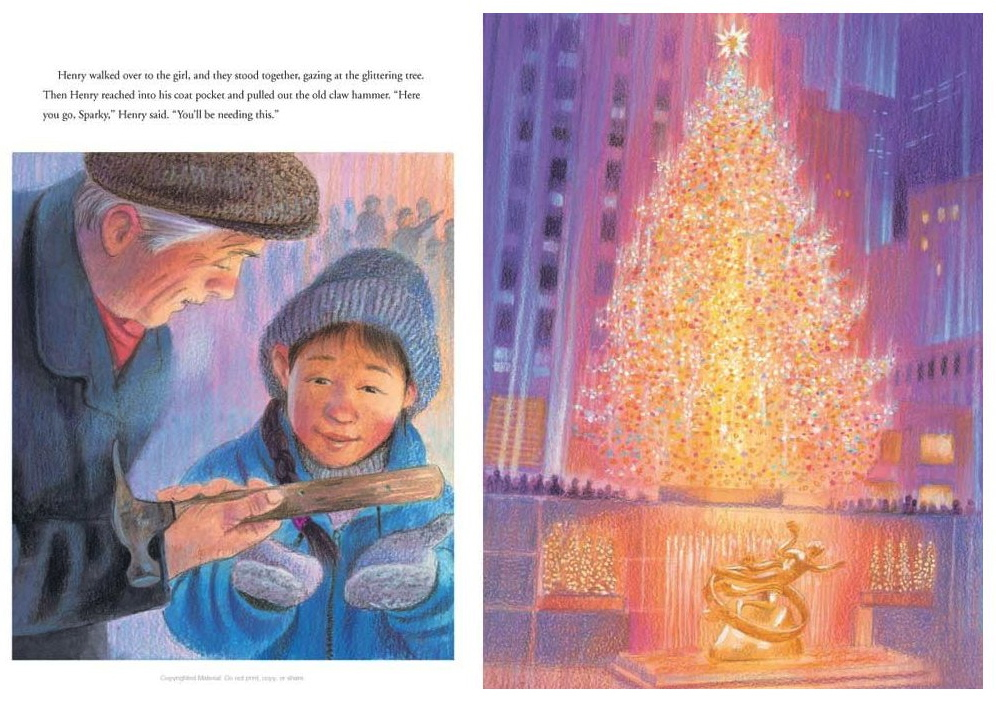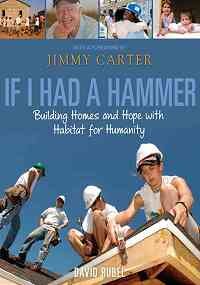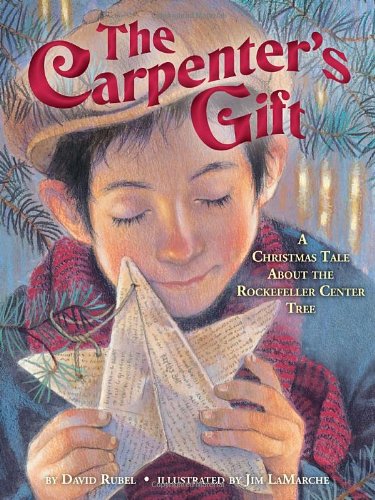80th Anniversary Blog Tour
The Children’s Book Review
Published: November 21, 2012
 This year marks the 80th Anniversary of the Rockefeller Center Tree—the tree lighting will take place on Wednesday, November 28th— and we’re honored here at TCBR to kick off the Random House blog tour for The carpenter’s Gift: A Christmas Tale about the Rockefeller Center Tree by talking to author David Rubel.
This year marks the 80th Anniversary of the Rockefeller Center Tree—the tree lighting will take place on Wednesday, November 28th— and we’re honored here at TCBR to kick off the Random House blog tour for The carpenter’s Gift: A Christmas Tale about the Rockefeller Center Tree by talking to author David Rubel.
Rubel is a brilliant man enlightened in the art of language and history. His brilliance shines through in our interview and his many inspiring and informative books; such as, If I Had a Hammer: Building Homes and HopeandScholastic Encyclopedia of the Presidents and Their Times.
The carpenter’s Gift (written in collaboration with Habitat for Humanity and illustrations by Jim LaMarche) captures the essence of giving and charity, showing the importance of compassion during the holidays.
Bianca Schulze: “If ever there was a magic moment, Henry thought, this is it.” Throughout the story there are two prominent magical moments for your protagonist Henry. Which of these two experiences would you consider your own personal highlight?
David Rubel: For me, the second “magic moment,” when Henry watches the young girl pick up the pinecone and stuff it in her pocket, is the more powerful because it represents a connection being made between people across time. When Henry first encounters the magic in 1931, we don’t yet know what will come of it. Henry’s experience may just be one great day in the life of a Depression-era child. As the story unfolds, we see that the magic transforms Henry’s life, but we still don’t know whether it will be passed on in any way. The sequence of events at the very end of the story, especially Henry’s gift of the hammer to the young girl, tells us that the magic will endure and that the girl will keep it alive as Henry has.

BS: The colored-pencil illustrations by Jim LaMarche are evocative of the 1930′s era, depression time, and warm the soul with their glow. What were your thoughts when you saw the finished illustrations combined with your text?
DR: While writing the book, I would occasionally muse about what the accompanying art should look like. It was important to me that the illustrations evoke the era of the Great Depression. A number of styles were popular during that time, especially art deco, the style in which Rockefeller Center was designed. But art deco was much too sleek and glitzy a style for this material. Instead, I thought a better choice would be the style developed by the muralists who worked during the Depression for the Works Progress Administration. These artists used a simple, unaugmented technique to show the pride and integrity of average Americans trying to make their way in the world, and that look seemed to me quite appropriate for Henry’s story.
The first time that I spoke with Jim LaMarche, he told me that he had recently visited Coit Tower in San Francisco, which has several WPA murals. What would I think, he asked, about his illustrating The Carpenter’s Gift in that style? If ever there was a magic moment, that was it!
 BS: This is your second book that revolves around the organization Habitat for Humanity. The first was in collaboration with former president Jimmy Carter: If I Had a Hammer: Building Homes and Hope with Habitat for Humanity. What does it mean to you to write books that highlight such a wonderful organization? And, while we’re at it, how did you collaborate with former president Carter?
BS: This is your second book that revolves around the organization Habitat for Humanity. The first was in collaboration with former president Jimmy Carter: If I Had a Hammer: Building Homes and Hope with Habitat for Humanity. What does it mean to you to write books that highlight such a wonderful organization? And, while we’re at it, how did you collaborate with former president Carter?
DR: Before I began researching If I Had a Hammer, I knew only what everybody else knows about Habitat for Humanity: that the organization builds homes for poor people. It didn’t take me long, however, to realize that, in fact, I had no idea what Habitat really does. For example, Habitat doesn’t build home for people in need; it builds homes with them. That is, Habitat doesn’t give the homes away. Instead, it raises the money needed to build simple, decent, affordable homes and then sells each home to a partner family at cost through no-profit mortgages. In this way, the organization offers a hand up rather than a handout. Then, Habitat uses the mortgage income from the homes it has already built to fund the construction of even more homes. That’s why Braveheart screenwriter Randall Wallace calls the organization a “perpetual-motion miracle.”
I learned the mechanics of the Habitat system from reading documents, but it was President Carter who taught me about the human dimension. He is, as you know, a very bright and articulate man, and he has thought a great deal about philanthropy in general and Habitat in particular. He explained to me that the gap between the haves and the have-nots is a “chasm” so wide that no single person can cross it on his own. The economic, social, and cultural differences are just too great—and that’s where Habitat comes in. Habitat, he said, provides a bridge that allows people to cross the chasm, come together, and find redemption.
BS: Have you had the opportunity to help build a home through the organization?
DR: After I wrote If I Had a Hammer, my wife, Julia, and I began volunteering regularly with our local Habitat affiliate. We’ve also traveled to build homes with some of the friends we’ve made in the Habitat community nationwide. One of our most rewarding trips was to build with a group called the Habitat Road Trip Crazies. Led by Lynchburg, Virginia, contractor Tom Gerdy, the Crazies work with small affiliates in the mid-Atlantic states to create “blitz builds.” For the Crazies, that means two houses in a single weekend. Tom and coconspirators Chuck Doremus and Larry Owen make this happen by bringing upwards of 100 volunteers to the job site. It’s quite an experience and an incredible amount of fun. For twenty years now, according to Tom, he has been trying to give more than he gets from his work with Habitat. But no matter how hard he tries, he says, he always gets more back.
BS: The majority of your written work fits the genre of history. Have you always been a history buff?
DR: Sort of. I actually came to history through an interest in the politics of the 1960s. In high school (during the mid- to late 1970s), I read books like James Simon Kunen’s The Strawberry Statement and James Michener’s Kent State. A little further afield but still of interest to me were works like Robert Caro’s The Powerbroker and Bob Woodward and Scott Armstrong’s The Brethren. At the time, the subjects of these books were still “current events.” But as I got older and maintained my interest in the period—still trying to figure out just what had happened and why—I moved from what you might call a social scientist to a historian.
BS: Could you tell us about any upcoming books or projects that you’re working on?
DR: I’ve just finished two projects. One is an update to my Scholastic Encyclopedia of the Presidents and Their Times. I prepare a new edition every four years to incorporate the most recent election cycle. It’s interesting work because it really is a “first draft” of history. It feels like writing a review of a movie whose end you haven’t seen—which reminds me of one of my favorite aphorisms. The philosopher G. W. F. Hegel once wrote that “The owl of Minerva flies only at dusk,” by which he meant that wisdom takes wing only after the events of the day have been completed.
The project that has taken up much more of my time recently is a companion book to Steven Spielberg’s new film Lincoln. For that project, I wrote a historical essay that gives a broader view of the events depicted in the film. I also interviewed a dozen of the filmmakers (including some of the actors) to create a journalistic account of how these professionals used their crafts to bring Lincoln’s White House to life. My favorite conversation was with sound designer Ben Burtt, who won an Academy Award for his work on Star Wars (he created the “voice” of R2-D2). Ben made it his mission to record as many sounds as he could that Lincoln would have actually heard. For example, there are several scenes in the film in which the president looks at his pocket watch. The ticking of the watch heard by the audience could have been the ticking of any antique watch, but Ben spent months tracking down a watch actually owned by Lincoln so that he could record its ticking for the movie.
BS: Is there a piece of history that you’ve yet to tackle that you are most looking forward to sharing with young readers?
DR: Although I’ve written two books about the civil rights movement (an illustrated history called The Coming Free and a children’s biography of Fannie Lou Hamer), I still haven’t gotten around to writing about the 1960s as an era. Because I was literally a child of the Sixties, having been born in 1961, I can remember what it felt like to be alive at that time, especially the feeling of possibility and the sense that something historically important was going on. My subsequent education has taught me that this feeling was essentially illusory—that the massive material forces influencing our behavior are always equally at work. It’s just that we think about them in different ways at different times. Even so, that doesn’t make the feeling of being alive at a historical cusp any less interesting or beguiling.
The metaphor I like best is that of a surfer riding an enormous wave—a tsunami. The surfer represents the baby boom generation, and the wave is the irresistible force of history. As the exhilarated surfer moves back and forth across the curl of the wave, exercising his free will, he gets the distinct impression that he is somehow controlling, or at least manipulating, the wave. And because he is young and this experience is all he has known, he fully expects it to last forever. Furthermore, he can’t understand why everyone else—the “squares”—aren’t surfing the wave, too. Then the wave breaks, and the surfer is wiped out. What does he do then? That’s a question I’d like to answer, but it will probably take several years and many hundreds of pages.
Add this Book to Your Collection
The Carpenter’s Gift: A Christmas Tale About the Rockfeller Center Christmas Tree
By David Rubel; Illustrated by Jim LaMarche / Random House Children’s Books
ISBN: 978-0-375-86922-8 / Ebook: 978-0-375-98067-1
More Information
Blog Tour Dates
Wednesday, November 21st, 2012: TheChildrensBookReview.com
Thursday, November 22nd, 2012: CrackingtheCover.com
Friday, November 23rd, 2012: The Book Maven’s Haven
Saturday, November 24th, 2012: BookingMama.com
Sunday, November 25th, 2012: {Eat the Book}
Monday, November 26th, 2012: Maestra Amanda’s Boohkshelf
Tuesday, November 27th, 2012: HeiseReads.com
Wednesday, November 28th, 2012

